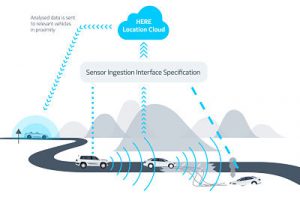Cars and trucks – manual or self-driving – will very soon be able to see what’s coming around the next corner or over a hill and automatically avoid collisions without having line-of-sight using cloud-based technologies.
Sound far-fetched? Hold that thought.
The grand vision of a world filled with driverless cars that instantly communicate with each other to make transport a stress free, totally automated and intelligent experience has have generated huge attention lately … but the really big and basic questions over how future transport systems will evolve are really still up in the air.
Sure, car makers, traffic authorities and technology companies are all racing towards a big shiny autonomous dream, but the far more basic issue of who will write the ‘language’ of data standards and protocols that ultimately dictates how vehicles talk to each other still hasn’t been decided.
But that could be about to change.
On Wednesday location technology developer HERE announced what it claims is a major step forward in thrashing out a global consensus on what kind of technical lingua franca autonomous vehicles will speak, saying that more than “more than 11 major automotive manufacturers and suppliers” had agreed to its open data standard dubbed SENSORIS.
The agreement’s potentially a very big deal because it could form the basis of a workable consensus on which interoperable international standards for autonomous vehicles can be built.
Global technical standards are, for the main, one of the driest and most eye-glazing subjects around – predictably, they garner little or no publicity as a result. But they’re still critically important as the bedrock foundations for technologies that need to work the world over to realise their potential.
Boring, yes. Irrelevant? No way.

The internet, aviation, telecommunications, credit cards, banking, satellites, navigation and even customs and postal systems would all come unstuck without global standards. Think the technical equivalent of the biblical Tower of Babel scenario (or Australia’s rail gauges SNAFU).
According to HERE, companies that have already joined what it calls the SENSORIS Innovation Platform include AISIN AW, Robert Bosch, Continental, Daimler, Elektrobit, HARMAN, HERE, LG Electronics, Jaguar Landrover, NavInfo, PIONEER and TomTom.
Ok, BuzzFeed keywords like Tesla, Apple, Uber, Trump, Kardashian, kittens, General Motors [etc] don’t quite make the cut, but the point is there’s some real momentum happening without big name brand dropping.
“More organisations are expected to join in the coming weeks,” HERE said in its announcement.
The design for the universal data format for vehicular chat (that’s SENSORIS) has also been submitted to Europe’s public/private partnership for helping to develop intelligent transport systems, a peak industry body called ERTICO-ITS Europe.
And things are genuinely starting to move quickly on the technical language front, even if the official talk is stills preferences dry accuracy over fluffy buzzwords.
“Defining a standardised interface for exchanging information between the in-vehicle sensors and a dedicated cloud as well as between clouds will enable broad access, delivery and processing of vehicle sensor data,” said ERTICO’s chief executive Hermann Meyer.
“[It will] enable easy exchange of vehicle sensor data between all players, and finally enable enriched location based services which are key for mobility services as well as for automated driving.”
The soundbite version of that statement is that car makers are desperate to avoid a repeat of the compatibility wars that can fragment developing industries. Betamax vs VHS; Apple vs PC, left hand drive vs right hand drive – and too many electrical power plug and voltage standards to point to.
HERE’s Asia Pacific director, Brent Stafford, has an Australian spin on the concept.
“Driverless vehicles need more than just these sensors to provide a smooth and safe driving experience, Stafford says. “They need to communicate with all other vehicles on the road, sending, receiving, interpreting and responding to live route conditions in real-time, Stafford says.”
“By speaking a universal data language, in the future, a German built autonomous truck driving down an Australian highway will be able to warn a driverless Japanese sedan and US made SUV following close behind to ‘slow down’ or ‘change lanes’ because of a wombat or mob of kangaroos near the road ahead.”
Our favourite example of ‘vehicular multiculturalism’ from Stafford revolves around trying to find a park from the incredible shrinking pool of spaces.
“Perhaps a Holden parked in a busy neighbourhood could notify a BMW that has been circling nearby, that a parking spot has just become available in the adjacent space,” he says.
Well it certainly wouldn’t offer it to a Ford. That would be un-Australian.
If Government News had its way, intelligent self-driving cars would be able to detect approaching parking inspectors and drive-off before they could issue a ticket.
That would be technological progress.
Comment below to have your say on this story.
If you have a news story or tip-off, get in touch at editorial@governmentnews.com.au.
Sign up to the Government News newsletter
